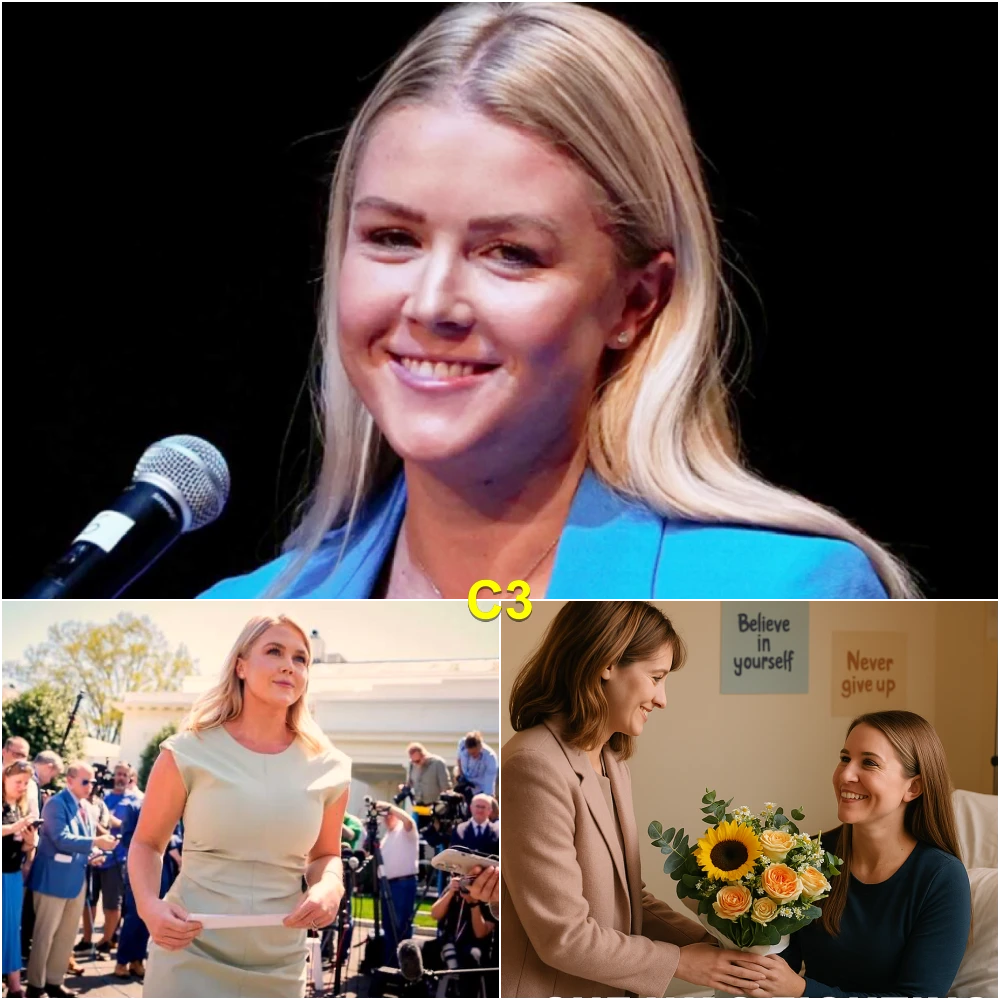Teen Girl Sells Her Art to Afford Chemo—Then Karoline Leavitt Walks By, And Everything Changes
On a gray spring morning in Manchester, New Hampshire, Emily Carter, age 15, sat alone in the pediatric oncology ward of St. Anne’s Hospital. The hum of IV pumps, the quiet shuffle of nurses, and the flicker of fluorescent lights had become part of her daily rhythm. She wasn’t scared anymore—just tired.
She clutched her sketchbook with pale fingers, her once-vibrant energy now dulled by rounds of chemotherapy. Her doctors had just told her she’d need two more rounds, but her family’s insurance coverage had reached its limit.
Her mother, seated beside her, whispered promises that they’d “figure it out.” But Emily wasn’t naive.
She knew the cost. And she knew her family didn’t have it.

A Quiet Decision
That night, as the city lights glowed beyond her hospital window, Emily flipped through her sketchbook and made a decision.
She would sell her paintings.
If her art was the one thing she could control, then it would become her weapon—a paintbrush against despair.
The Sidewalk Gallery
By the next weekend, Emily had set up a folding table on Elm Street, the city’s busiest pedestrian lane. Her canvases were modest but beautiful: oceans and deserts, starry skies, wildflowers. A sign sat at the front of the table:
“Original Art. Helping Fund My Chemotherapy.”
The first few hours were hard. People smiled politely and kept walking. Some looked uncomfortable. Others didn’t see her at all.
But she didn’t stop.
Then, an elderly couple bought a painting of a lilac field. It was only eight dollars, but to Emily, it felt like a miracle.
The Woman in the Blue Coat
Later that afternoon, just as Emily was beginning to pack up, a woman in her twenties approached—dressed in a powder-blue coat and black boots, her brown hair swept into a loose bun.
She knelt beside the table, scanning the paintings in silence.
“You painted these?” she asked gently.
Emily nodded.
“Why?”
Emily shrugged. “Because it’s the only thing I have to fight with.”
The woman studied her for a long moment before smiling.
“What’s your name?”
“Emily Carter.”
The woman extended her hand.
“I’m Karoline. Karoline Leavitt.”
Emily blinked, recognizing the name—not just from local politics, but from a speech she’d seen online about youth empowerment.
The Twist That Changed Everything
Karoline flipped through the paintings again and landed on one—a black-and-white piece showing a girl standing on a cliff under a swirl of stars.
“How much for this one?”
“Two hundred dollars,” Emily said, barely above a whisper.
Karoline pulled out a small leather checkbook and began writing.
But when she handed it to Emily, the number made her hands tremble.
“Fifty thousand dollars.”
Emily gasped. “Is… is this a mistake?”
Karoline smiled softly. “It’s not charity. It’s a commission. I want to support your fight—and your art.”
The crowd around them, once unaware, began to gather. Whispers turned to applause. Phones came out. Photos snapped.
Emily’s mother arrived moments later, in tears, as Karoline stood beside her daughter and said:
“No one should ever have to sell their survival. Not in this country. But if you do, let the world see your light.”
The Ripple Effect
Within 24 hours, the photo went viral:
“Teen Sells Art to Fund Chemo. Karoline Leavitt Steps In—and Changes Everything.”
Media outlets picked up the story. Donations poured in. A Boston gallery offered to represent Emily’s work. Teachers requested classroom prints. Even a local museum created a small exhibit called “Brushstrokes of Resilience.”
With Karoline’s support, Emily’s entire treatment was paid off.
A Personal Letter
Weeks later, after her final round of chemo, Emily received a hand-addressed envelope in the mail.
Inside was a note:
“Emily—
You reminded me that courage doesn’t always roar. Sometimes, it paints.
Keep creating. The world is better when you share your colors.
With admiration,
Karoline.”
The First Piece That Started It All
Emily’s original cliffside painting now hangs in Karoline Leavitt’s Concord office—a quiet reminder of a day when compassion won.
When asked about it in an interview, Karoline said:
“That painting showed me something I couldn’t unsee:
That sometimes, the fight for life doesn’t look like a protest or a vote.
Sometimes, it looks like a teenage girl, on a sidewalk, daring the world to notice her.”
Where Emily Is Now
Now 16, Emily is cancer-free.
She’s working on a new collection called “After the Storm.”
She plans to donate a portion of the proceeds to other young patients facing overwhelming medical costs.
Because as she says:
“I got my miracle.
Now I want to paint someone else’s.”





